Comparing Marketing Methods for Ticket Sales in Transport for London
VerifiedAdded on 2020/10/05
|11
|3870
|197
Report
AI Summary
This report provides an analysis of the effects of traditional and non-traditional marketing methods on the ticket-buying process within Transport for London (TFL). It begins with an introduction that defines both traditional marketing, such as print and advertisements, and non-traditional marketing, emphasizing creative and innovative approaches. The report explores the significance of the research, highlighting the importance of understanding how these marketing methods influence operational efficiency and customer satisfaction. The research aims to analyze the impact of these marketing strategies on TFL ticket sales, with specific objectives to understand the concepts of both traditional and non-traditional marketing, and to evaluate their differences. The literature review examines traditional methods like print and broadcast advertising, noting their time-consuming nature, and contrasts them with non-traditional approaches such as online ticketing and street campaigns, which offer convenience and cost-effectiveness. The methodology section outlines the research philosophy, approach, strategy, sampling techniques, data collection methods, and ethical considerations. The report concludes by recommending ways of analyzing the influence of traditional versus non-traditional marketing in the ticket buying process.
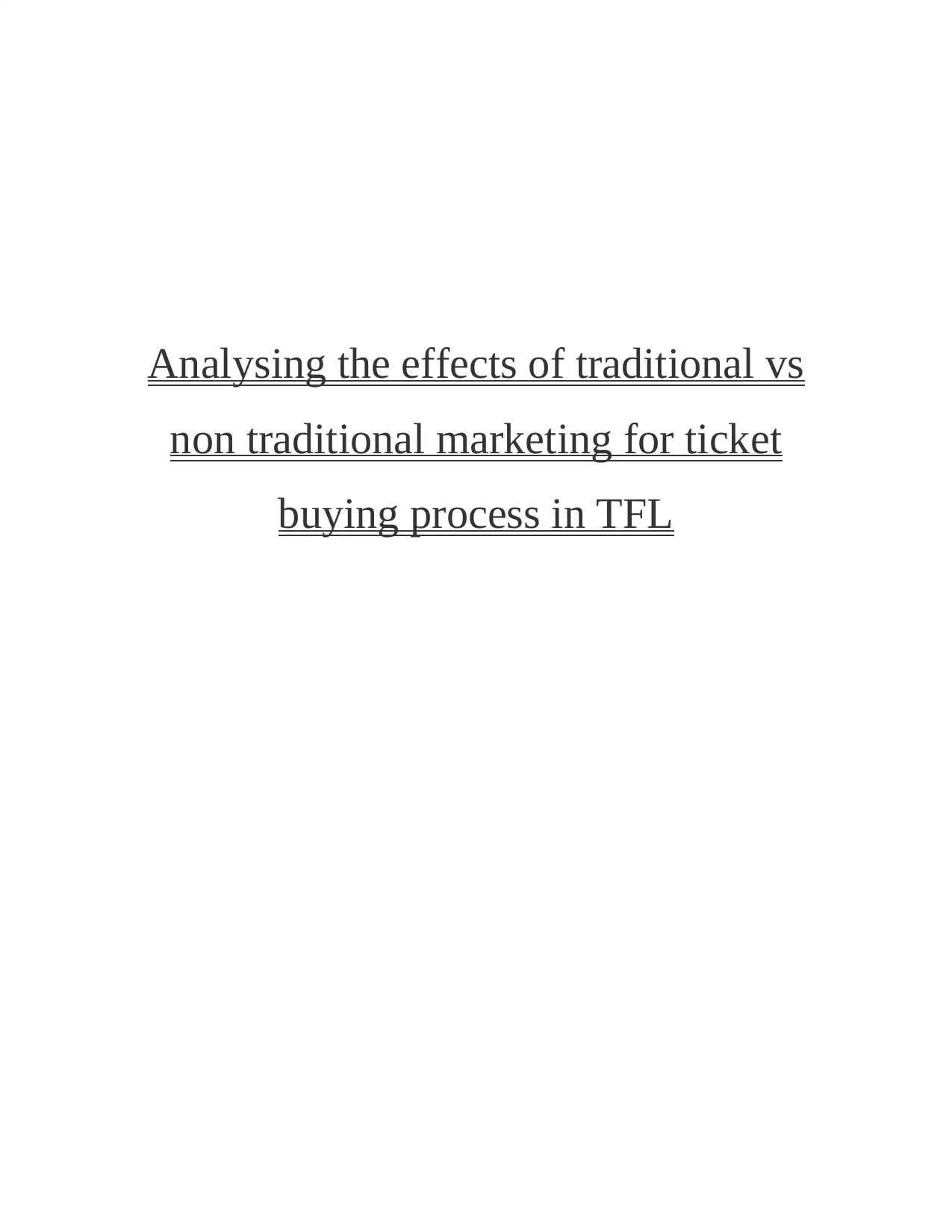
Analysing the effects of traditional vs
non traditional marketing for ticket
buying process in TFL
non traditional marketing for ticket
buying process in TFL
Paraphrase This Document
Need a fresh take? Get an instant paraphrase of this document with our AI Paraphraser
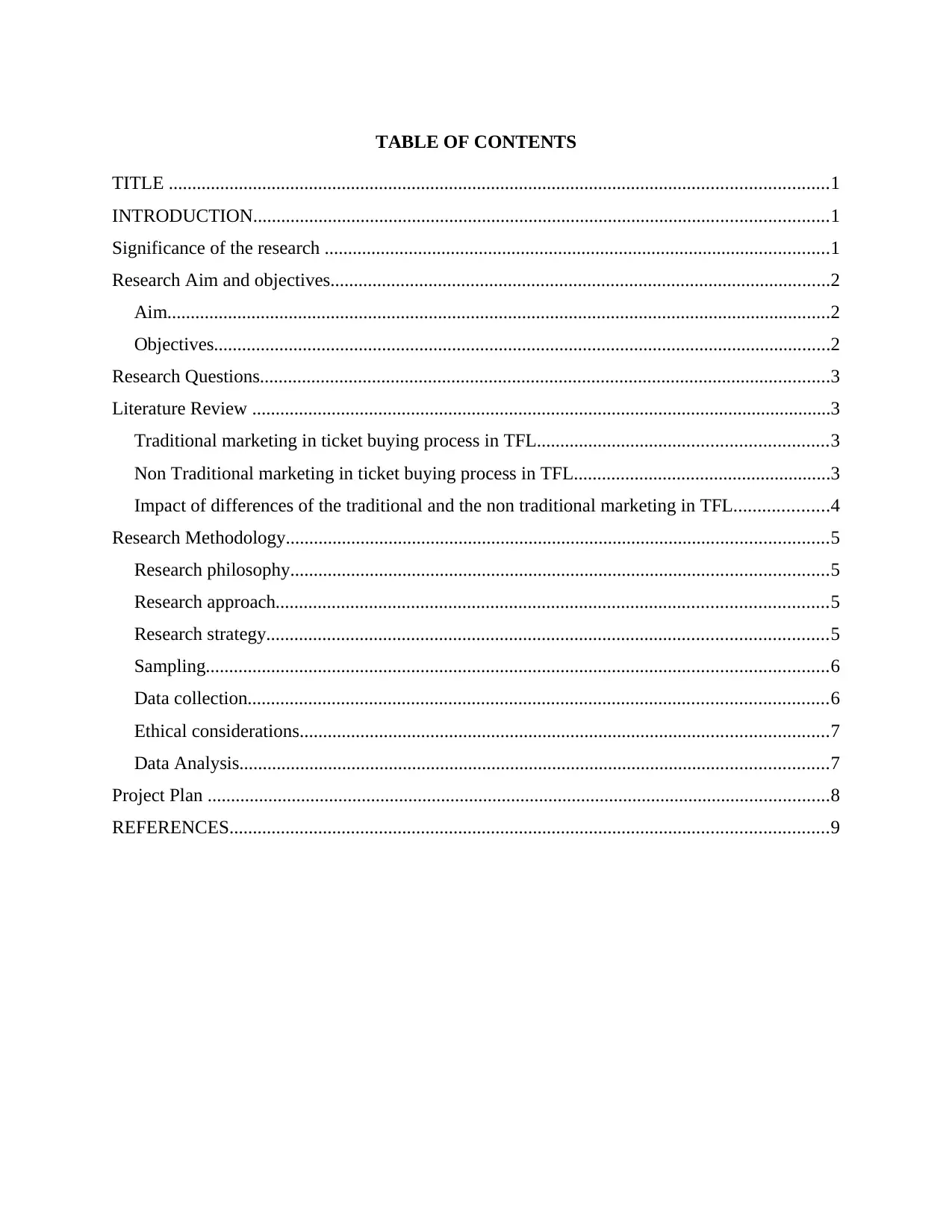
TABLE OF CONTENTS
TITLE .............................................................................................................................................1
INTRODUCTION...........................................................................................................................1
Significance of the research ............................................................................................................1
Research Aim and objectives...........................................................................................................2
Aim..............................................................................................................................................2
Objectives....................................................................................................................................2
Research Questions..........................................................................................................................3
Literature Review ............................................................................................................................3
Traditional marketing in ticket buying process in TFL..............................................................3
Non Traditional marketing in ticket buying process in TFL.......................................................3
Impact of differences of the traditional and the non traditional marketing in TFL....................4
Research Methodology....................................................................................................................5
Research philosophy...................................................................................................................5
Research approach......................................................................................................................5
Research strategy........................................................................................................................5
Sampling.....................................................................................................................................6
Data collection............................................................................................................................6
Ethical considerations.................................................................................................................7
Data Analysis..............................................................................................................................7
Project Plan .....................................................................................................................................8
REFERENCES................................................................................................................................9
TITLE .............................................................................................................................................1
INTRODUCTION...........................................................................................................................1
Significance of the research ............................................................................................................1
Research Aim and objectives...........................................................................................................2
Aim..............................................................................................................................................2
Objectives....................................................................................................................................2
Research Questions..........................................................................................................................3
Literature Review ............................................................................................................................3
Traditional marketing in ticket buying process in TFL..............................................................3
Non Traditional marketing in ticket buying process in TFL.......................................................3
Impact of differences of the traditional and the non traditional marketing in TFL....................4
Research Methodology....................................................................................................................5
Research philosophy...................................................................................................................5
Research approach......................................................................................................................5
Research strategy........................................................................................................................5
Sampling.....................................................................................................................................6
Data collection............................................................................................................................6
Ethical considerations.................................................................................................................7
Data Analysis..............................................................................................................................7
Project Plan .....................................................................................................................................8
REFERENCES................................................................................................................................9
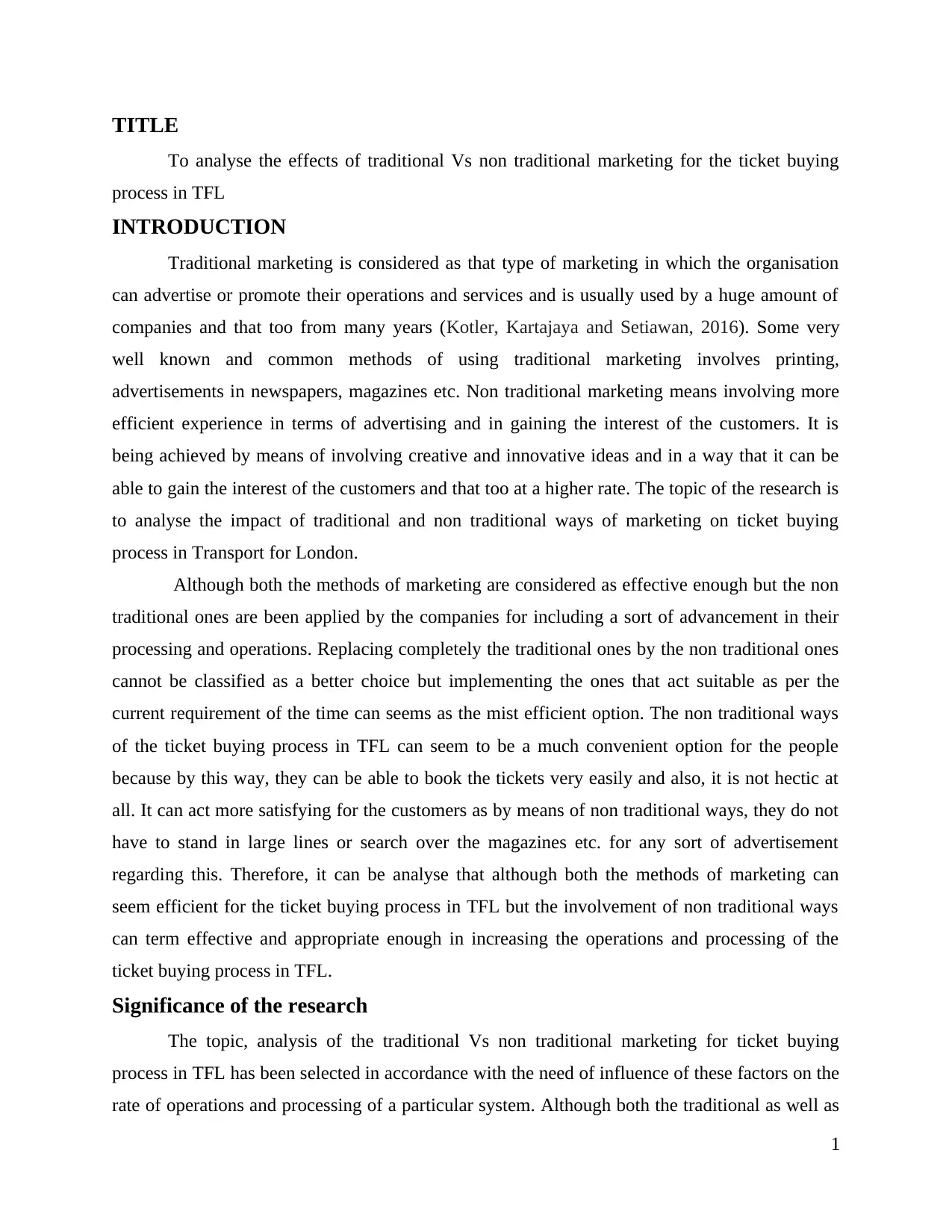
TITLE
To analyse the effects of traditional Vs non traditional marketing for the ticket buying
process in TFL
INTRODUCTION
Traditional marketing is considered as that type of marketing in which the organisation
can advertise or promote their operations and services and is usually used by a huge amount of
companies and that too from many years (Kotler, Kartajaya and Setiawan, 2016). Some very
well known and common methods of using traditional marketing involves printing,
advertisements in newspapers, magazines etc. Non traditional marketing means involving more
efficient experience in terms of advertising and in gaining the interest of the customers. It is
being achieved by means of involving creative and innovative ideas and in a way that it can be
able to gain the interest of the customers and that too at a higher rate. The topic of the research is
to analyse the impact of traditional and non traditional ways of marketing on ticket buying
process in Transport for London.
Although both the methods of marketing are considered as effective enough but the non
traditional ones are been applied by the companies for including a sort of advancement in their
processing and operations. Replacing completely the traditional ones by the non traditional ones
cannot be classified as a better choice but implementing the ones that act suitable as per the
current requirement of the time can seems as the mist efficient option. The non traditional ways
of the ticket buying process in TFL can seem to be a much convenient option for the people
because by this way, they can be able to book the tickets very easily and also, it is not hectic at
all. It can act more satisfying for the customers as by means of non traditional ways, they do not
have to stand in large lines or search over the magazines etc. for any sort of advertisement
regarding this. Therefore, it can be analyse that although both the methods of marketing can
seem efficient for the ticket buying process in TFL but the involvement of non traditional ways
can term effective and appropriate enough in increasing the operations and processing of the
ticket buying process in TFL.
Significance of the research
The topic, analysis of the traditional Vs non traditional marketing for ticket buying
process in TFL has been selected in accordance with the need of influence of these factors on the
rate of operations and processing of a particular system. Although both the traditional as well as
1
To analyse the effects of traditional Vs non traditional marketing for the ticket buying
process in TFL
INTRODUCTION
Traditional marketing is considered as that type of marketing in which the organisation
can advertise or promote their operations and services and is usually used by a huge amount of
companies and that too from many years (Kotler, Kartajaya and Setiawan, 2016). Some very
well known and common methods of using traditional marketing involves printing,
advertisements in newspapers, magazines etc. Non traditional marketing means involving more
efficient experience in terms of advertising and in gaining the interest of the customers. It is
being achieved by means of involving creative and innovative ideas and in a way that it can be
able to gain the interest of the customers and that too at a higher rate. The topic of the research is
to analyse the impact of traditional and non traditional ways of marketing on ticket buying
process in Transport for London.
Although both the methods of marketing are considered as effective enough but the non
traditional ones are been applied by the companies for including a sort of advancement in their
processing and operations. Replacing completely the traditional ones by the non traditional ones
cannot be classified as a better choice but implementing the ones that act suitable as per the
current requirement of the time can seems as the mist efficient option. The non traditional ways
of the ticket buying process in TFL can seem to be a much convenient option for the people
because by this way, they can be able to book the tickets very easily and also, it is not hectic at
all. It can act more satisfying for the customers as by means of non traditional ways, they do not
have to stand in large lines or search over the magazines etc. for any sort of advertisement
regarding this. Therefore, it can be analyse that although both the methods of marketing can
seem efficient for the ticket buying process in TFL but the involvement of non traditional ways
can term effective and appropriate enough in increasing the operations and processing of the
ticket buying process in TFL.
Significance of the research
The topic, analysis of the traditional Vs non traditional marketing for ticket buying
process in TFL has been selected in accordance with the need of influence of these factors on the
rate of operations and processing of a particular system. Although both the traditional as well as
1
⊘ This is a preview!⊘
Do you want full access?
Subscribe today to unlock all pages.

Trusted by 1+ million students worldwide
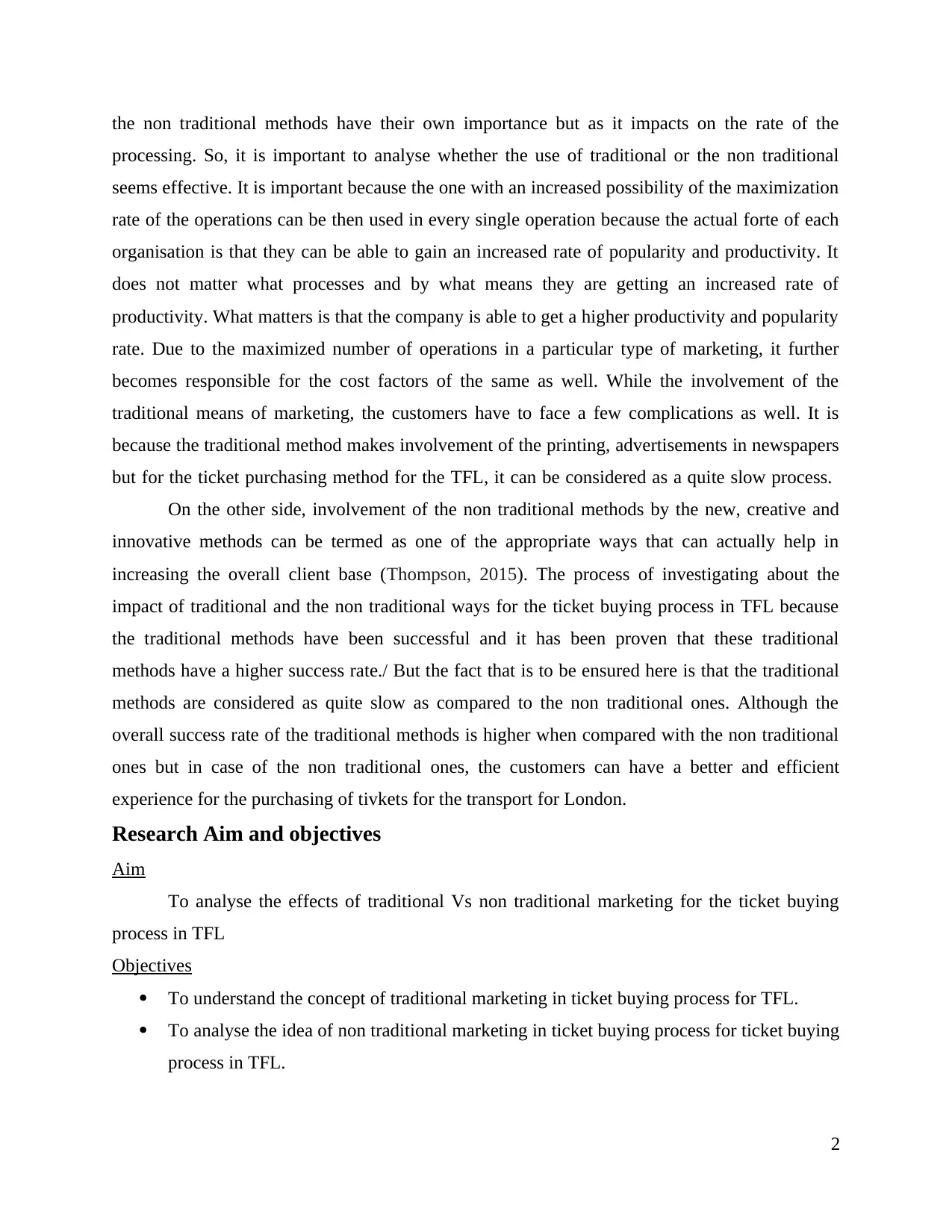
the non traditional methods have their own importance but as it impacts on the rate of the
processing. So, it is important to analyse whether the use of traditional or the non traditional
seems effective. It is important because the one with an increased possibility of the maximization
rate of the operations can be then used in every single operation because the actual forte of each
organisation is that they can be able to gain an increased rate of popularity and productivity. It
does not matter what processes and by what means they are getting an increased rate of
productivity. What matters is that the company is able to get a higher productivity and popularity
rate. Due to the maximized number of operations in a particular type of marketing, it further
becomes responsible for the cost factors of the same as well. While the involvement of the
traditional means of marketing, the customers have to face a few complications as well. It is
because the traditional method makes involvement of the printing, advertisements in newspapers
but for the ticket purchasing method for the TFL, it can be considered as a quite slow process.
On the other side, involvement of the non traditional methods by the new, creative and
innovative methods can be termed as one of the appropriate ways that can actually help in
increasing the overall client base (Thompson, 2015). The process of investigating about the
impact of traditional and the non traditional ways for the ticket buying process in TFL because
the traditional methods have been successful and it has been proven that these traditional
methods have a higher success rate./ But the fact that is to be ensured here is that the traditional
methods are considered as quite slow as compared to the non traditional ones. Although the
overall success rate of the traditional methods is higher when compared with the non traditional
ones but in case of the non traditional ones, the customers can have a better and efficient
experience for the purchasing of tivkets for the transport for London.
Research Aim and objectives
Aim
To analyse the effects of traditional Vs non traditional marketing for the ticket buying
process in TFL
Objectives
To understand the concept of traditional marketing in ticket buying process for TFL.
To analyse the idea of non traditional marketing in ticket buying process for ticket buying
process in TFL.
2
processing. So, it is important to analyse whether the use of traditional or the non traditional
seems effective. It is important because the one with an increased possibility of the maximization
rate of the operations can be then used in every single operation because the actual forte of each
organisation is that they can be able to gain an increased rate of popularity and productivity. It
does not matter what processes and by what means they are getting an increased rate of
productivity. What matters is that the company is able to get a higher productivity and popularity
rate. Due to the maximized number of operations in a particular type of marketing, it further
becomes responsible for the cost factors of the same as well. While the involvement of the
traditional means of marketing, the customers have to face a few complications as well. It is
because the traditional method makes involvement of the printing, advertisements in newspapers
but for the ticket purchasing method for the TFL, it can be considered as a quite slow process.
On the other side, involvement of the non traditional methods by the new, creative and
innovative methods can be termed as one of the appropriate ways that can actually help in
increasing the overall client base (Thompson, 2015). The process of investigating about the
impact of traditional and the non traditional ways for the ticket buying process in TFL because
the traditional methods have been successful and it has been proven that these traditional
methods have a higher success rate./ But the fact that is to be ensured here is that the traditional
methods are considered as quite slow as compared to the non traditional ones. Although the
overall success rate of the traditional methods is higher when compared with the non traditional
ones but in case of the non traditional ones, the customers can have a better and efficient
experience for the purchasing of tivkets for the transport for London.
Research Aim and objectives
Aim
To analyse the effects of traditional Vs non traditional marketing for the ticket buying
process in TFL
Objectives
To understand the concept of traditional marketing in ticket buying process for TFL.
To analyse the idea of non traditional marketing in ticket buying process for ticket buying
process in TFL.
2
Paraphrase This Document
Need a fresh take? Get an instant paraphrase of this document with our AI Paraphraser
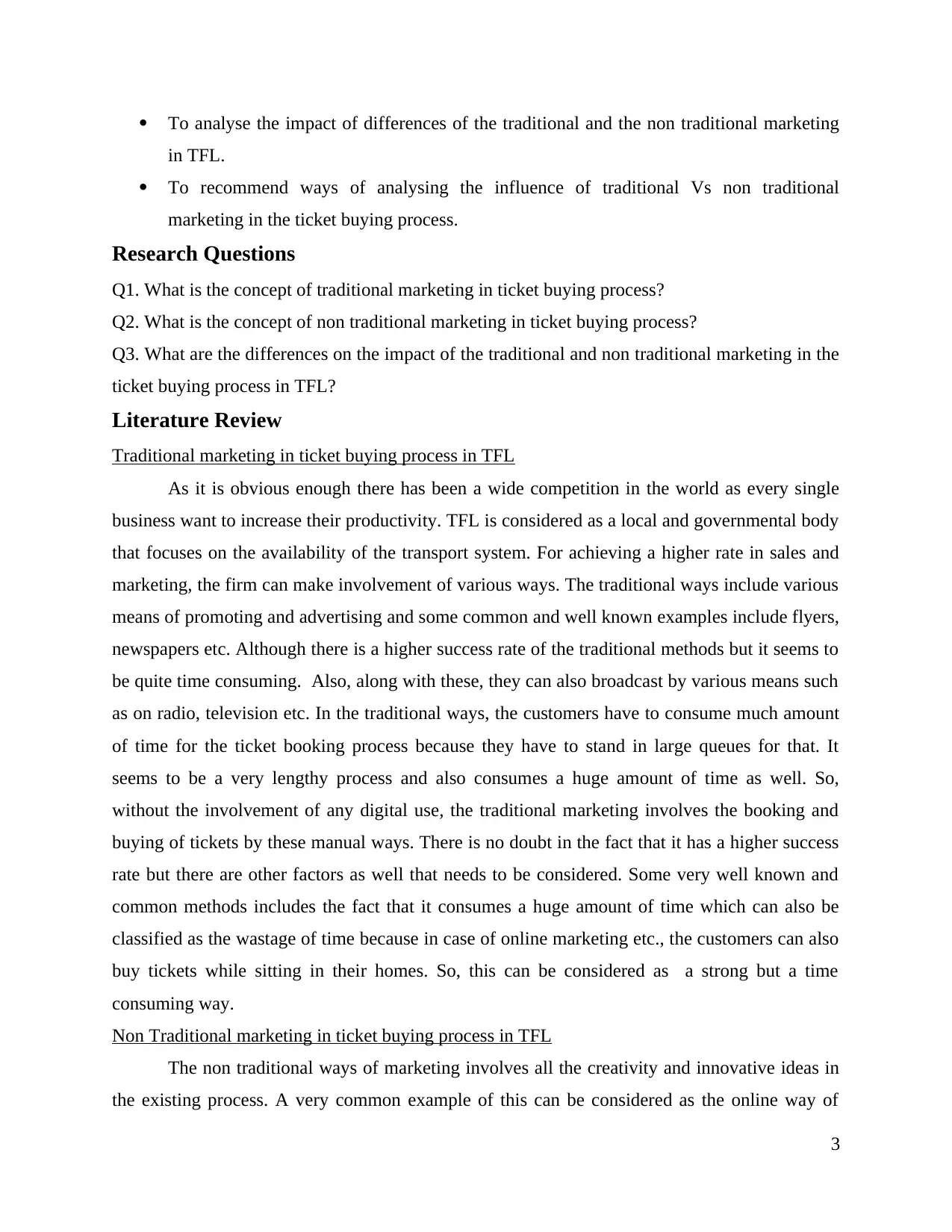
To analyse the impact of differences of the traditional and the non traditional marketing
in TFL.
To recommend ways of analysing the influence of traditional Vs non traditional
marketing in the ticket buying process.
Research Questions
Q1. What is the concept of traditional marketing in ticket buying process?
Q2. What is the concept of non traditional marketing in ticket buying process?
Q3. What are the differences on the impact of the traditional and non traditional marketing in the
ticket buying process in TFL?
Literature Review
Traditional marketing in ticket buying process in TFL
As it is obvious enough there has been a wide competition in the world as every single
business want to increase their productivity. TFL is considered as a local and governmental body
that focuses on the availability of the transport system. For achieving a higher rate in sales and
marketing, the firm can make involvement of various ways. The traditional ways include various
means of promoting and advertising and some common and well known examples include flyers,
newspapers etc. Although there is a higher success rate of the traditional methods but it seems to
be quite time consuming. Also, along with these, they can also broadcast by various means such
as on radio, television etc. In the traditional ways, the customers have to consume much amount
of time for the ticket booking process because they have to stand in large queues for that. It
seems to be a very lengthy process and also consumes a huge amount of time as well. So,
without the involvement of any digital use, the traditional marketing involves the booking and
buying of tickets by these manual ways. There is no doubt in the fact that it has a higher success
rate but there are other factors as well that needs to be considered. Some very well known and
common methods includes the fact that it consumes a huge amount of time which can also be
classified as the wastage of time because in case of online marketing etc., the customers can also
buy tickets while sitting in their homes. So, this can be considered as a strong but a time
consuming way.
Non Traditional marketing in ticket buying process in TFL
The non traditional ways of marketing involves all the creativity and innovative ideas in
the existing process. A very common example of this can be considered as the online way of
3
in TFL.
To recommend ways of analysing the influence of traditional Vs non traditional
marketing in the ticket buying process.
Research Questions
Q1. What is the concept of traditional marketing in ticket buying process?
Q2. What is the concept of non traditional marketing in ticket buying process?
Q3. What are the differences on the impact of the traditional and non traditional marketing in the
ticket buying process in TFL?
Literature Review
Traditional marketing in ticket buying process in TFL
As it is obvious enough there has been a wide competition in the world as every single
business want to increase their productivity. TFL is considered as a local and governmental body
that focuses on the availability of the transport system. For achieving a higher rate in sales and
marketing, the firm can make involvement of various ways. The traditional ways include various
means of promoting and advertising and some common and well known examples include flyers,
newspapers etc. Although there is a higher success rate of the traditional methods but it seems to
be quite time consuming. Also, along with these, they can also broadcast by various means such
as on radio, television etc. In the traditional ways, the customers have to consume much amount
of time for the ticket booking process because they have to stand in large queues for that. It
seems to be a very lengthy process and also consumes a huge amount of time as well. So,
without the involvement of any digital use, the traditional marketing involves the booking and
buying of tickets by these manual ways. There is no doubt in the fact that it has a higher success
rate but there are other factors as well that needs to be considered. Some very well known and
common methods includes the fact that it consumes a huge amount of time which can also be
classified as the wastage of time because in case of online marketing etc., the customers can also
buy tickets while sitting in their homes. So, this can be considered as a strong but a time
consuming way.
Non Traditional marketing in ticket buying process in TFL
The non traditional ways of marketing involves all the creativity and innovative ideas in
the existing process. A very common example of this can be considered as the online way of
3
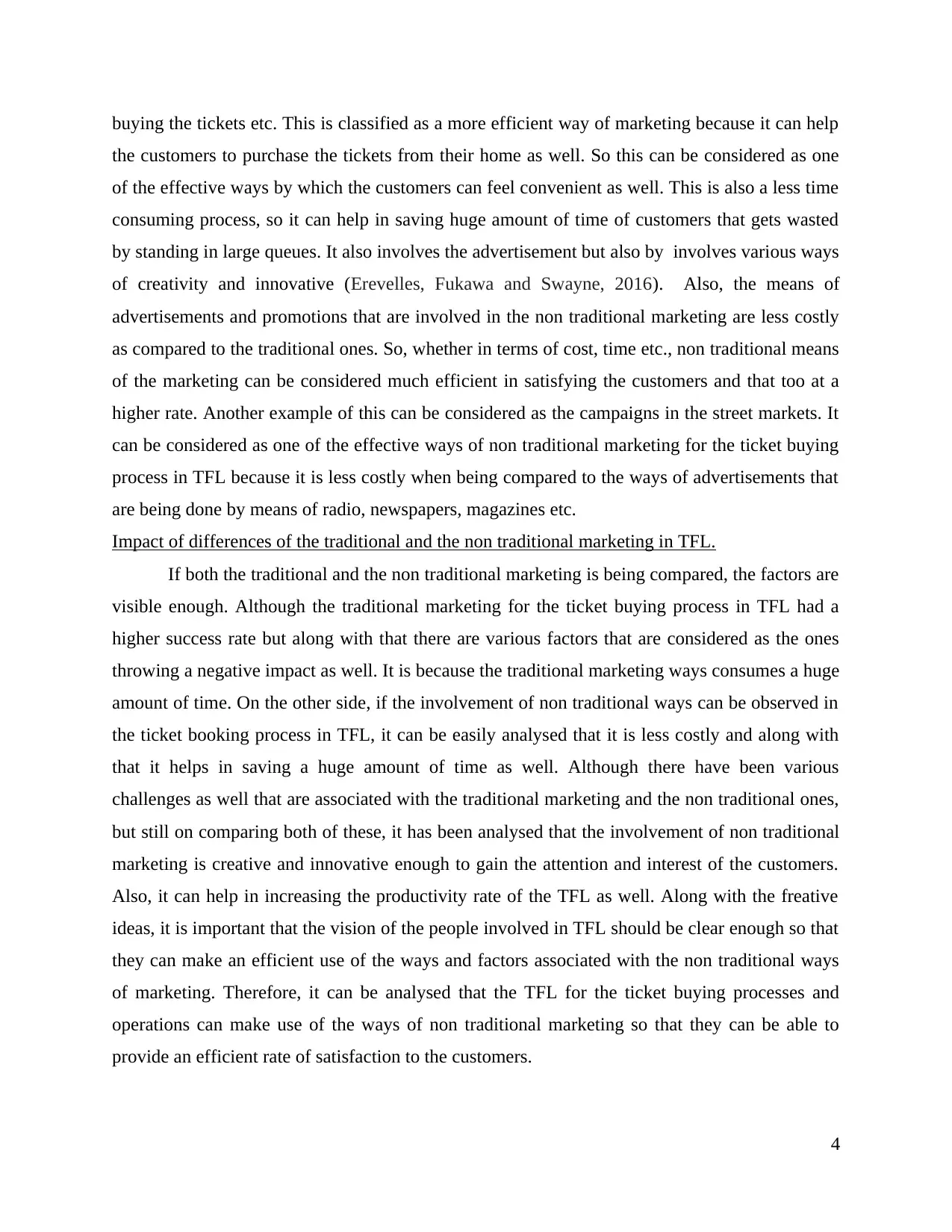
buying the tickets etc. This is classified as a more efficient way of marketing because it can help
the customers to purchase the tickets from their home as well. So this can be considered as one
of the effective ways by which the customers can feel convenient as well. This is also a less time
consuming process, so it can help in saving huge amount of time of customers that gets wasted
by standing in large queues. It also involves the advertisement but also by involves various ways
of creativity and innovative (Erevelles, Fukawa and Swayne, 2016). Also, the means of
advertisements and promotions that are involved in the non traditional marketing are less costly
as compared to the traditional ones. So, whether in terms of cost, time etc., non traditional means
of the marketing can be considered much efficient in satisfying the customers and that too at a
higher rate. Another example of this can be considered as the campaigns in the street markets. It
can be considered as one of the effective ways of non traditional marketing for the ticket buying
process in TFL because it is less costly when being compared to the ways of advertisements that
are being done by means of radio, newspapers, magazines etc.
Impact of differences of the traditional and the non traditional marketing in TFL.
If both the traditional and the non traditional marketing is being compared, the factors are
visible enough. Although the traditional marketing for the ticket buying process in TFL had a
higher success rate but along with that there are various factors that are considered as the ones
throwing a negative impact as well. It is because the traditional marketing ways consumes a huge
amount of time. On the other side, if the involvement of non traditional ways can be observed in
the ticket booking process in TFL, it can be easily analysed that it is less costly and along with
that it helps in saving a huge amount of time as well. Although there have been various
challenges as well that are associated with the traditional marketing and the non traditional ones,
but still on comparing both of these, it has been analysed that the involvement of non traditional
marketing is creative and innovative enough to gain the attention and interest of the customers.
Also, it can help in increasing the productivity rate of the TFL as well. Along with the freative
ideas, it is important that the vision of the people involved in TFL should be clear enough so that
they can make an efficient use of the ways and factors associated with the non traditional ways
of marketing. Therefore, it can be analysed that the TFL for the ticket buying processes and
operations can make use of the ways of non traditional marketing so that they can be able to
provide an efficient rate of satisfaction to the customers.
4
the customers to purchase the tickets from their home as well. So this can be considered as one
of the effective ways by which the customers can feel convenient as well. This is also a less time
consuming process, so it can help in saving huge amount of time of customers that gets wasted
by standing in large queues. It also involves the advertisement but also by involves various ways
of creativity and innovative (Erevelles, Fukawa and Swayne, 2016). Also, the means of
advertisements and promotions that are involved in the non traditional marketing are less costly
as compared to the traditional ones. So, whether in terms of cost, time etc., non traditional means
of the marketing can be considered much efficient in satisfying the customers and that too at a
higher rate. Another example of this can be considered as the campaigns in the street markets. It
can be considered as one of the effective ways of non traditional marketing for the ticket buying
process in TFL because it is less costly when being compared to the ways of advertisements that
are being done by means of radio, newspapers, magazines etc.
Impact of differences of the traditional and the non traditional marketing in TFL.
If both the traditional and the non traditional marketing is being compared, the factors are
visible enough. Although the traditional marketing for the ticket buying process in TFL had a
higher success rate but along with that there are various factors that are considered as the ones
throwing a negative impact as well. It is because the traditional marketing ways consumes a huge
amount of time. On the other side, if the involvement of non traditional ways can be observed in
the ticket booking process in TFL, it can be easily analysed that it is less costly and along with
that it helps in saving a huge amount of time as well. Although there have been various
challenges as well that are associated with the traditional marketing and the non traditional ones,
but still on comparing both of these, it has been analysed that the involvement of non traditional
marketing is creative and innovative enough to gain the attention and interest of the customers.
Also, it can help in increasing the productivity rate of the TFL as well. Along with the freative
ideas, it is important that the vision of the people involved in TFL should be clear enough so that
they can make an efficient use of the ways and factors associated with the non traditional ways
of marketing. Therefore, it can be analysed that the TFL for the ticket buying processes and
operations can make use of the ways of non traditional marketing so that they can be able to
provide an efficient rate of satisfaction to the customers.
4
⊘ This is a preview!⊘
Do you want full access?
Subscribe today to unlock all pages.

Trusted by 1+ million students worldwide
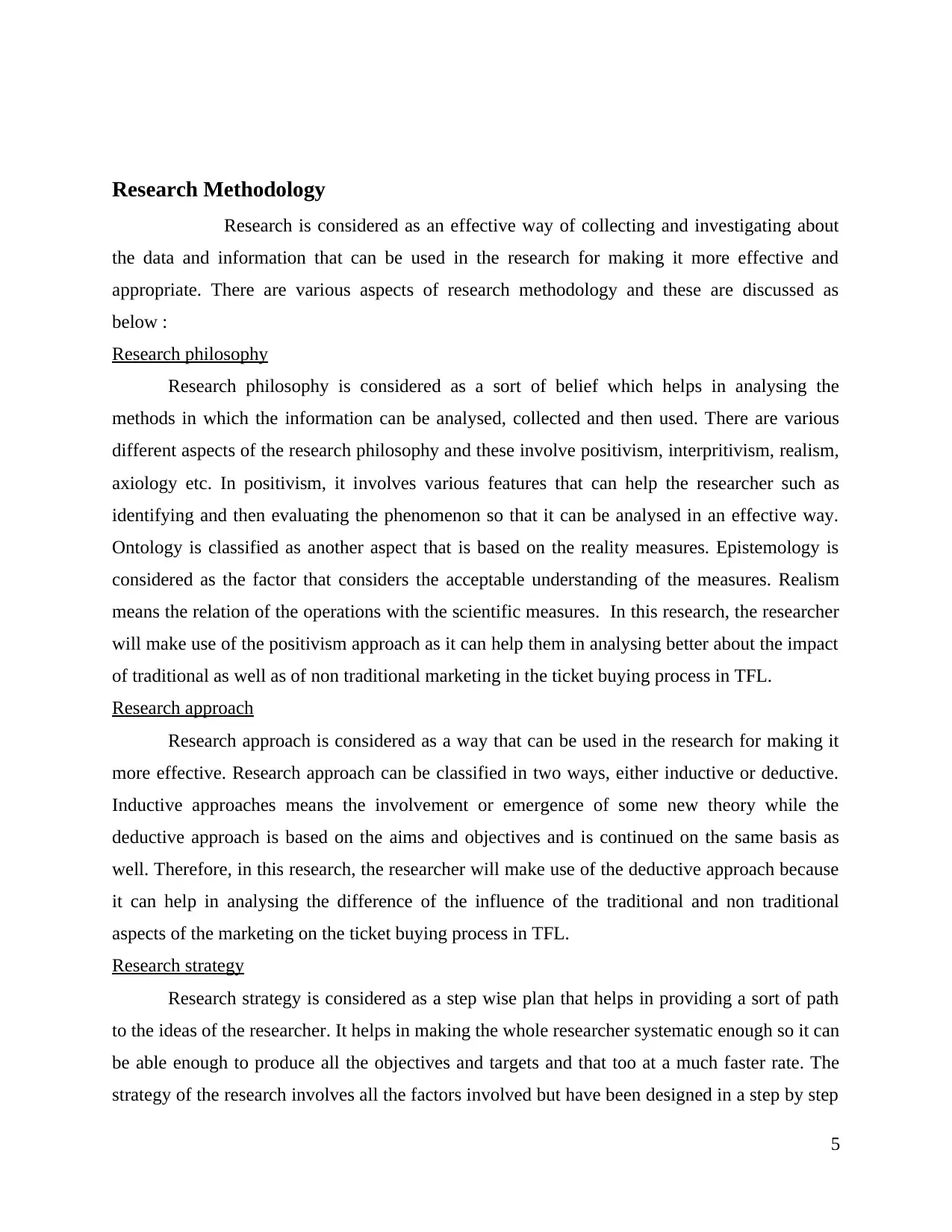
Research Methodology
Research is considered as an effective way of collecting and investigating about
the data and information that can be used in the research for making it more effective and
appropriate. There are various aspects of research methodology and these are discussed as
below :
Research philosophy
Research philosophy is considered as a sort of belief which helps in analysing the
methods in which the information can be analysed, collected and then used. There are various
different aspects of the research philosophy and these involve positivism, interpritivism, realism,
axiology etc. In positivism, it involves various features that can help the researcher such as
identifying and then evaluating the phenomenon so that it can be analysed in an effective way.
Ontology is classified as another aspect that is based on the reality measures. Epistemology is
considered as the factor that considers the acceptable understanding of the measures. Realism
means the relation of the operations with the scientific measures. In this research, the researcher
will make use of the positivism approach as it can help them in analysing better about the impact
of traditional as well as of non traditional marketing in the ticket buying process in TFL.
Research approach
Research approach is considered as a way that can be used in the research for making it
more effective. Research approach can be classified in two ways, either inductive or deductive.
Inductive approaches means the involvement or emergence of some new theory while the
deductive approach is based on the aims and objectives and is continued on the same basis as
well. Therefore, in this research, the researcher will make use of the deductive approach because
it can help in analysing the difference of the influence of the traditional and non traditional
aspects of the marketing on the ticket buying process in TFL.
Research strategy
Research strategy is considered as a step wise plan that helps in providing a sort of path
to the ideas of the researcher. It helps in making the whole researcher systematic enough so it can
be able enough to produce all the objectives and targets and that too at a much faster rate. The
strategy of the research involves all the factors involved but have been designed in a step by step
5
Research is considered as an effective way of collecting and investigating about
the data and information that can be used in the research for making it more effective and
appropriate. There are various aspects of research methodology and these are discussed as
below :
Research philosophy
Research philosophy is considered as a sort of belief which helps in analysing the
methods in which the information can be analysed, collected and then used. There are various
different aspects of the research philosophy and these involve positivism, interpritivism, realism,
axiology etc. In positivism, it involves various features that can help the researcher such as
identifying and then evaluating the phenomenon so that it can be analysed in an effective way.
Ontology is classified as another aspect that is based on the reality measures. Epistemology is
considered as the factor that considers the acceptable understanding of the measures. Realism
means the relation of the operations with the scientific measures. In this research, the researcher
will make use of the positivism approach as it can help them in analysing better about the impact
of traditional as well as of non traditional marketing in the ticket buying process in TFL.
Research approach
Research approach is considered as a way that can be used in the research for making it
more effective. Research approach can be classified in two ways, either inductive or deductive.
Inductive approaches means the involvement or emergence of some new theory while the
deductive approach is based on the aims and objectives and is continued on the same basis as
well. Therefore, in this research, the researcher will make use of the deductive approach because
it can help in analysing the difference of the influence of the traditional and non traditional
aspects of the marketing on the ticket buying process in TFL.
Research strategy
Research strategy is considered as a step wise plan that helps in providing a sort of path
to the ideas of the researcher. It helps in making the whole researcher systematic enough so it can
be able enough to produce all the objectives and targets and that too at a much faster rate. The
strategy of the research involves all the factors involved but have been designed in a step by step
5
Paraphrase This Document
Need a fresh take? Get an instant paraphrase of this document with our AI Paraphraser
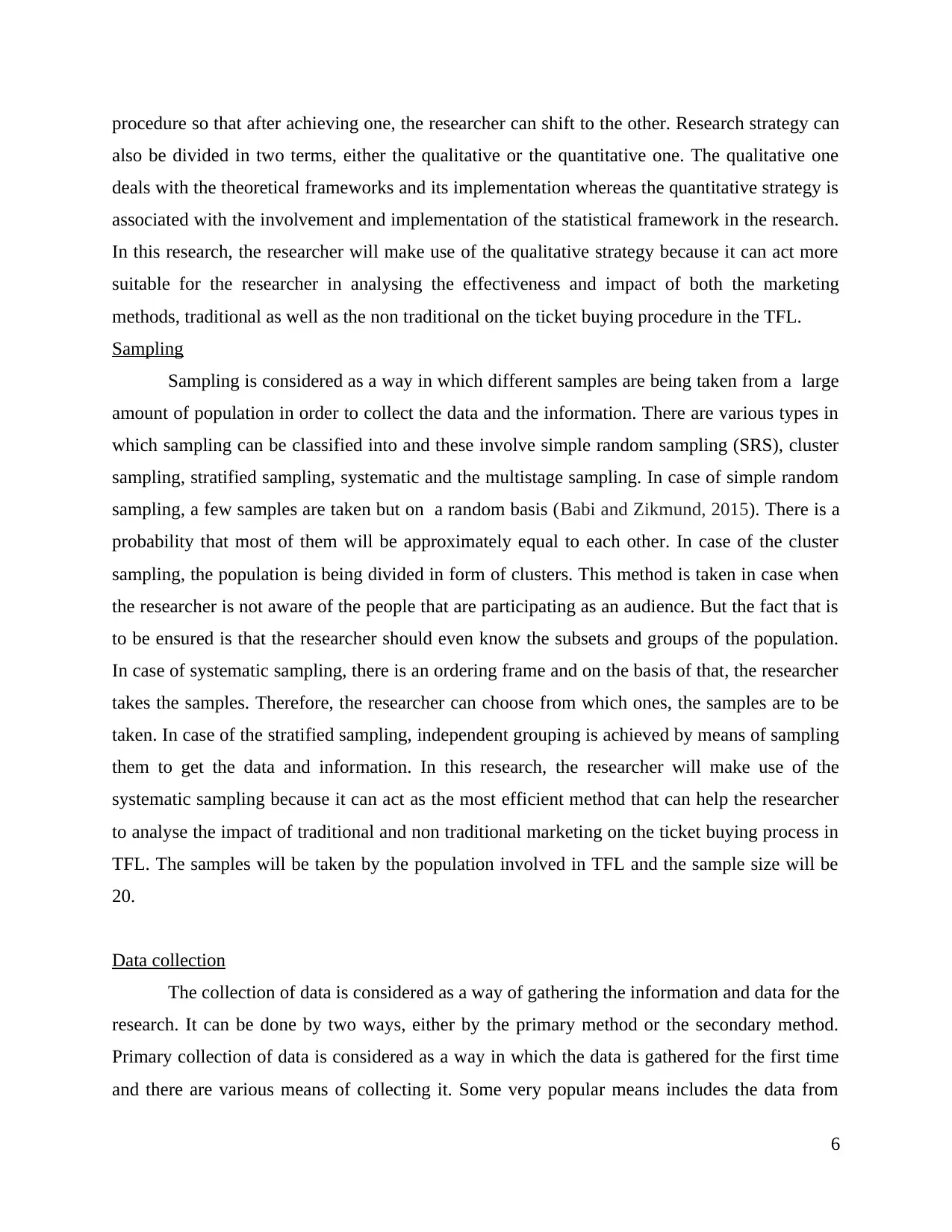
procedure so that after achieving one, the researcher can shift to the other. Research strategy can
also be divided in two terms, either the qualitative or the quantitative one. The qualitative one
deals with the theoretical frameworks and its implementation whereas the quantitative strategy is
associated with the involvement and implementation of the statistical framework in the research.
In this research, the researcher will make use of the qualitative strategy because it can act more
suitable for the researcher in analysing the effectiveness and impact of both the marketing
methods, traditional as well as the non traditional on the ticket buying procedure in the TFL.
Sampling
Sampling is considered as a way in which different samples are being taken from a large
amount of population in order to collect the data and the information. There are various types in
which sampling can be classified into and these involve simple random sampling (SRS), cluster
sampling, stratified sampling, systematic and the multistage sampling. In case of simple random
sampling, a few samples are taken but on a random basis (Babi and Zikmund, 2015). There is a
probability that most of them will be approximately equal to each other. In case of the cluster
sampling, the population is being divided in form of clusters. This method is taken in case when
the researcher is not aware of the people that are participating as an audience. But the fact that is
to be ensured is that the researcher should even know the subsets and groups of the population.
In case of systematic sampling, there is an ordering frame and on the basis of that, the researcher
takes the samples. Therefore, the researcher can choose from which ones, the samples are to be
taken. In case of the stratified sampling, independent grouping is achieved by means of sampling
them to get the data and information. In this research, the researcher will make use of the
systematic sampling because it can act as the most efficient method that can help the researcher
to analyse the impact of traditional and non traditional marketing on the ticket buying process in
TFL. The samples will be taken by the population involved in TFL and the sample size will be
20.
Data collection
The collection of data is considered as a way of gathering the information and data for the
research. It can be done by two ways, either by the primary method or the secondary method.
Primary collection of data is considered as a way in which the data is gathered for the first time
and there are various means of collecting it. Some very popular means includes the data from
6
also be divided in two terms, either the qualitative or the quantitative one. The qualitative one
deals with the theoretical frameworks and its implementation whereas the quantitative strategy is
associated with the involvement and implementation of the statistical framework in the research.
In this research, the researcher will make use of the qualitative strategy because it can act more
suitable for the researcher in analysing the effectiveness and impact of both the marketing
methods, traditional as well as the non traditional on the ticket buying procedure in the TFL.
Sampling
Sampling is considered as a way in which different samples are being taken from a large
amount of population in order to collect the data and the information. There are various types in
which sampling can be classified into and these involve simple random sampling (SRS), cluster
sampling, stratified sampling, systematic and the multistage sampling. In case of simple random
sampling, a few samples are taken but on a random basis (Babi and Zikmund, 2015). There is a
probability that most of them will be approximately equal to each other. In case of the cluster
sampling, the population is being divided in form of clusters. This method is taken in case when
the researcher is not aware of the people that are participating as an audience. But the fact that is
to be ensured is that the researcher should even know the subsets and groups of the population.
In case of systematic sampling, there is an ordering frame and on the basis of that, the researcher
takes the samples. Therefore, the researcher can choose from which ones, the samples are to be
taken. In case of the stratified sampling, independent grouping is achieved by means of sampling
them to get the data and information. In this research, the researcher will make use of the
systematic sampling because it can act as the most efficient method that can help the researcher
to analyse the impact of traditional and non traditional marketing on the ticket buying process in
TFL. The samples will be taken by the population involved in TFL and the sample size will be
20.
Data collection
The collection of data is considered as a way of gathering the information and data for the
research. It can be done by two ways, either by the primary method or the secondary method.
Primary collection of data is considered as a way in which the data is gathered for the first time
and there are various means of collecting it. Some very popular means includes the data from
6
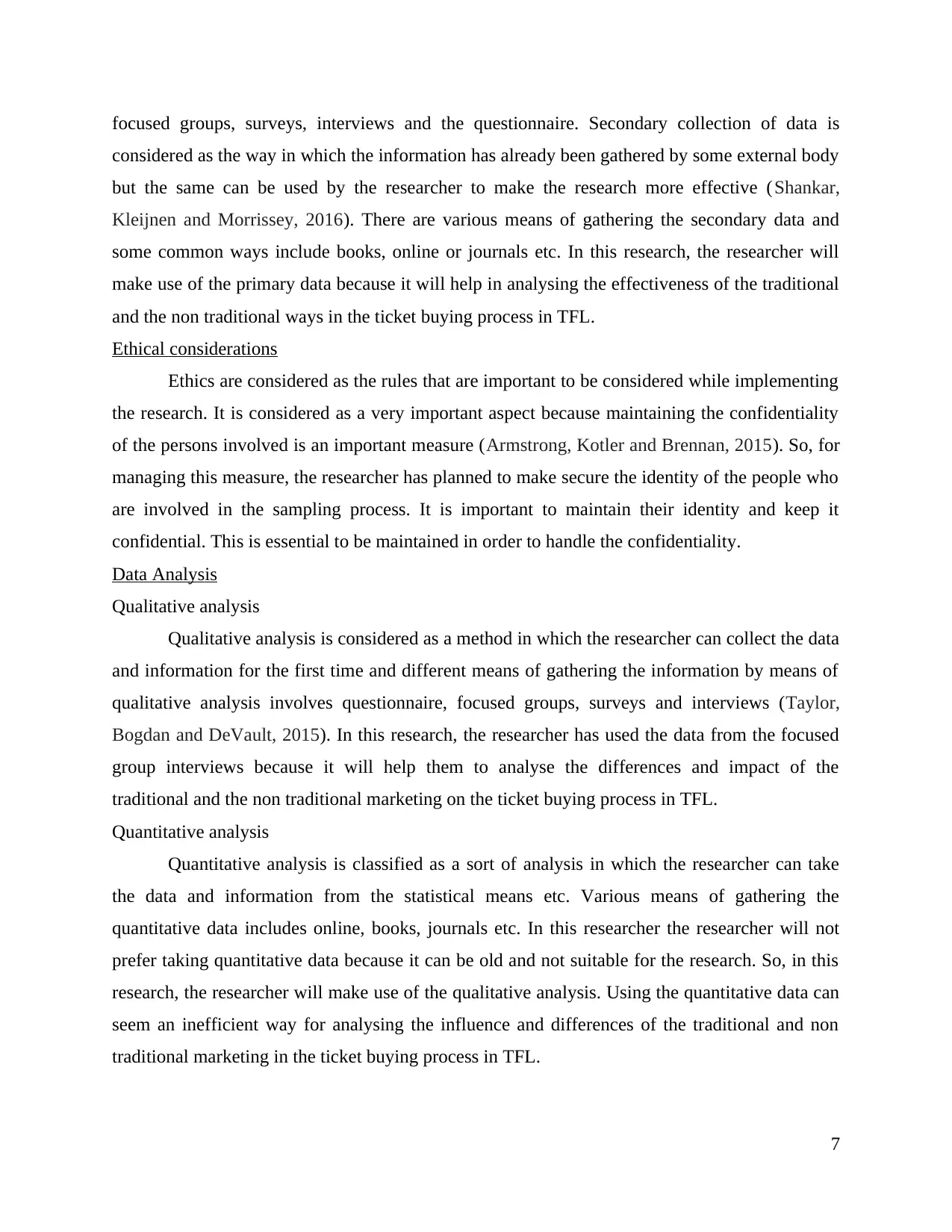
focused groups, surveys, interviews and the questionnaire. Secondary collection of data is
considered as the way in which the information has already been gathered by some external body
but the same can be used by the researcher to make the research more effective (Shankar,
Kleijnen and Morrissey, 2016). There are various means of gathering the secondary data and
some common ways include books, online or journals etc. In this research, the researcher will
make use of the primary data because it will help in analysing the effectiveness of the traditional
and the non traditional ways in the ticket buying process in TFL.
Ethical considerations
Ethics are considered as the rules that are important to be considered while implementing
the research. It is considered as a very important aspect because maintaining the confidentiality
of the persons involved is an important measure (Armstrong, Kotler and Brennan, 2015). So, for
managing this measure, the researcher has planned to make secure the identity of the people who
are involved in the sampling process. It is important to maintain their identity and keep it
confidential. This is essential to be maintained in order to handle the confidentiality.
Data Analysis
Qualitative analysis
Qualitative analysis is considered as a method in which the researcher can collect the data
and information for the first time and different means of gathering the information by means of
qualitative analysis involves questionnaire, focused groups, surveys and interviews (Taylor,
Bogdan and DeVault, 2015). In this research, the researcher has used the data from the focused
group interviews because it will help them to analyse the differences and impact of the
traditional and the non traditional marketing on the ticket buying process in TFL.
Quantitative analysis
Quantitative analysis is classified as a sort of analysis in which the researcher can take
the data and information from the statistical means etc. Various means of gathering the
quantitative data includes online, books, journals etc. In this researcher the researcher will not
prefer taking quantitative data because it can be old and not suitable for the research. So, in this
research, the researcher will make use of the qualitative analysis. Using the quantitative data can
seem an inefficient way for analysing the influence and differences of the traditional and non
traditional marketing in the ticket buying process in TFL.
7
considered as the way in which the information has already been gathered by some external body
but the same can be used by the researcher to make the research more effective (Shankar,
Kleijnen and Morrissey, 2016). There are various means of gathering the secondary data and
some common ways include books, online or journals etc. In this research, the researcher will
make use of the primary data because it will help in analysing the effectiveness of the traditional
and the non traditional ways in the ticket buying process in TFL.
Ethical considerations
Ethics are considered as the rules that are important to be considered while implementing
the research. It is considered as a very important aspect because maintaining the confidentiality
of the persons involved is an important measure (Armstrong, Kotler and Brennan, 2015). So, for
managing this measure, the researcher has planned to make secure the identity of the people who
are involved in the sampling process. It is important to maintain their identity and keep it
confidential. This is essential to be maintained in order to handle the confidentiality.
Data Analysis
Qualitative analysis
Qualitative analysis is considered as a method in which the researcher can collect the data
and information for the first time and different means of gathering the information by means of
qualitative analysis involves questionnaire, focused groups, surveys and interviews (Taylor,
Bogdan and DeVault, 2015). In this research, the researcher has used the data from the focused
group interviews because it will help them to analyse the differences and impact of the
traditional and the non traditional marketing on the ticket buying process in TFL.
Quantitative analysis
Quantitative analysis is classified as a sort of analysis in which the researcher can take
the data and information from the statistical means etc. Various means of gathering the
quantitative data includes online, books, journals etc. In this researcher the researcher will not
prefer taking quantitative data because it can be old and not suitable for the research. So, in this
research, the researcher will make use of the qualitative analysis. Using the quantitative data can
seem an inefficient way for analysing the influence and differences of the traditional and non
traditional marketing in the ticket buying process in TFL.
7
⊘ This is a preview!⊘
Do you want full access?
Subscribe today to unlock all pages.

Trusted by 1+ million students worldwide
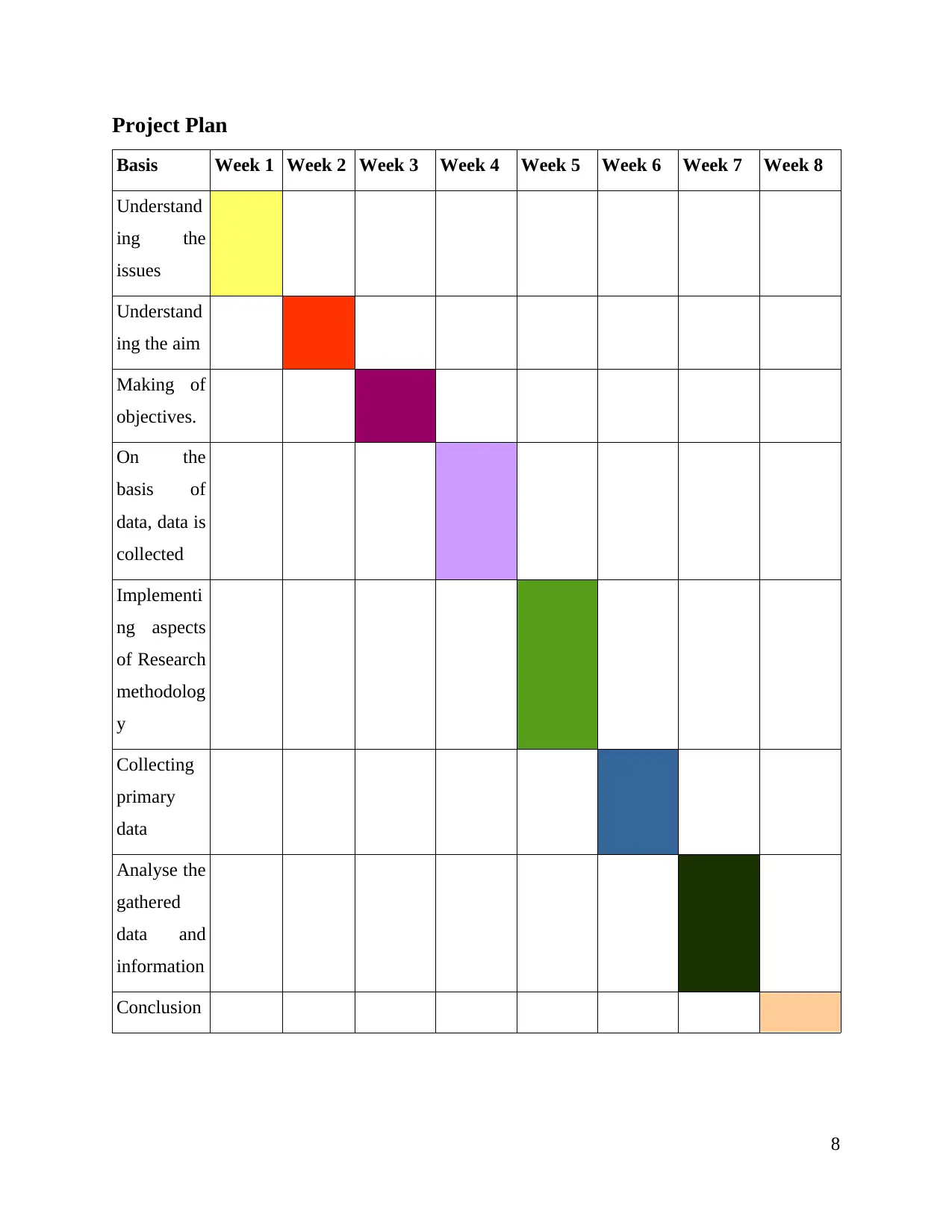
Project Plan
Basis Week 1 Week 2 Week 3 Week 4 Week 5 Week 6 Week 7 Week 8
Understand
ing the
issues
Understand
ing the aim
Making of
objectives.
On the
basis of
data, data is
collected
Implementi
ng aspects
of Research
methodolog
y
Collecting
primary
data
Analyse the
gathered
data and
information
Conclusion
8
Basis Week 1 Week 2 Week 3 Week 4 Week 5 Week 6 Week 7 Week 8
Understand
ing the
issues
Understand
ing the aim
Making of
objectives.
On the
basis of
data, data is
collected
Implementi
ng aspects
of Research
methodolog
y
Collecting
primary
data
Analyse the
gathered
data and
information
Conclusion
8
Paraphrase This Document
Need a fresh take? Get an instant paraphrase of this document with our AI Paraphraser
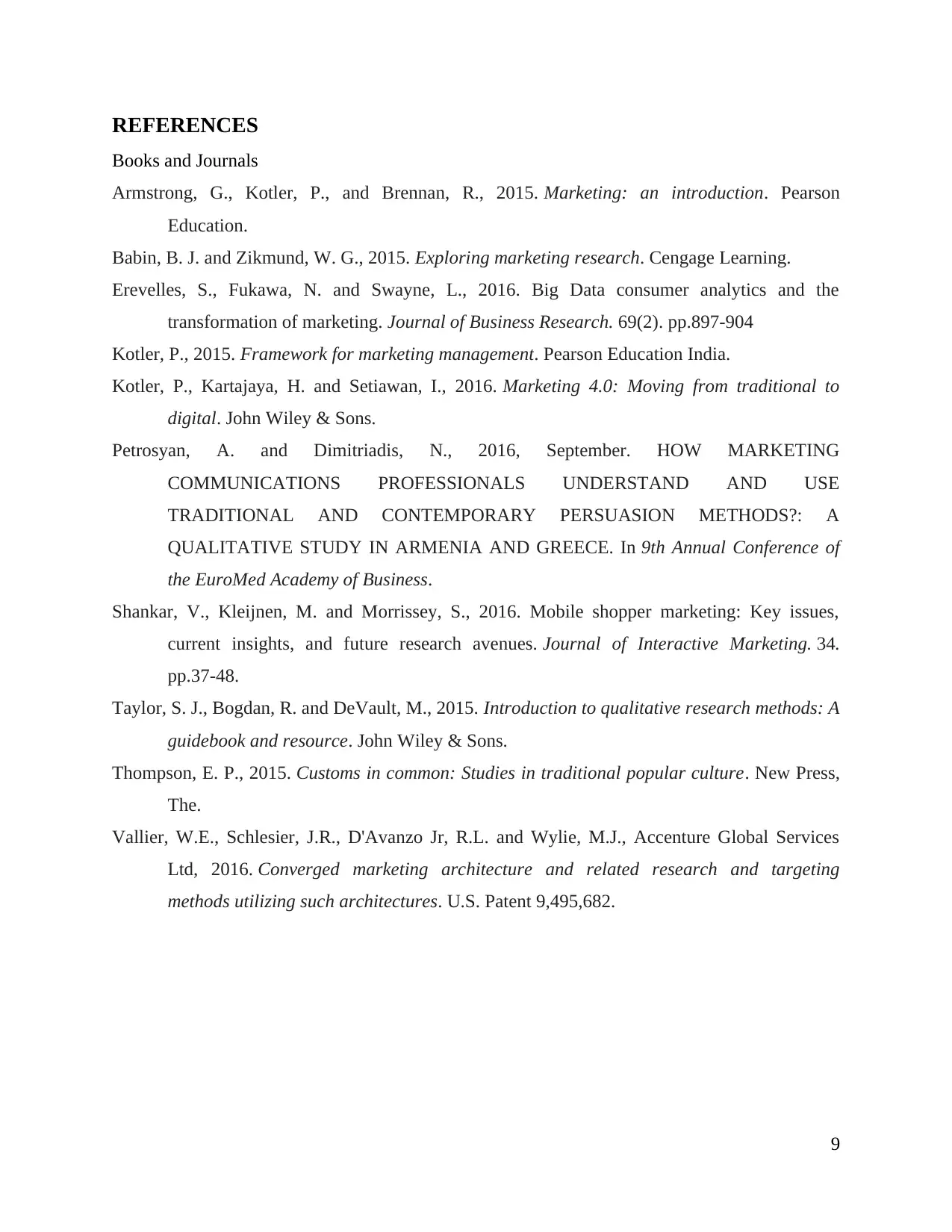
REFERENCES
Books and Journals
Armstrong, G., Kotler, P., and Brennan, R., 2015. Marketing: an introduction. Pearson
Education.
Babin, B. J. and Zikmund, W. G., 2015. Exploring marketing research. Cengage Learning.
Erevelles, S., Fukawa, N. and Swayne, L., 2016. Big Data consumer analytics and the
transformation of marketing. Journal of Business Research. 69(2). pp.897-904
Kotler, P., 2015. Framework for marketing management. Pearson Education India.
Kotler, P., Kartajaya, H. and Setiawan, I., 2016. Marketing 4.0: Moving from traditional to
digital. John Wiley & Sons.
Petrosyan, A. and Dimitriadis, N., 2016, September. HOW MARKETING
COMMUNICATIONS PROFESSIONALS UNDERSTAND AND USE
TRADITIONAL AND CONTEMPORARY PERSUASION METHODS?: A
QUALITATIVE STUDY IN ARMENIA AND GREECE. In 9th Annual Conference of
the EuroMed Academy of Business.
Shankar, V., Kleijnen, M. and Morrissey, S., 2016. Mobile shopper marketing: Key issues,
current insights, and future research avenues. Journal of Interactive Marketing. 34.
pp.37-48.
Taylor, S. J., Bogdan, R. and DeVault, M., 2015. Introduction to qualitative research methods: A
guidebook and resource. John Wiley & Sons.
Thompson, E. P., 2015. Customs in common: Studies in traditional popular culture. New Press,
The.
Vallier, W.E., Schlesier, J.R., D'Avanzo Jr, R.L. and Wylie, M.J., Accenture Global Services
Ltd, 2016. Converged marketing architecture and related research and targeting
methods utilizing such architectures. U.S. Patent 9,495,682.
9
Books and Journals
Armstrong, G., Kotler, P., and Brennan, R., 2015. Marketing: an introduction. Pearson
Education.
Babin, B. J. and Zikmund, W. G., 2015. Exploring marketing research. Cengage Learning.
Erevelles, S., Fukawa, N. and Swayne, L., 2016. Big Data consumer analytics and the
transformation of marketing. Journal of Business Research. 69(2). pp.897-904
Kotler, P., 2015. Framework for marketing management. Pearson Education India.
Kotler, P., Kartajaya, H. and Setiawan, I., 2016. Marketing 4.0: Moving from traditional to
digital. John Wiley & Sons.
Petrosyan, A. and Dimitriadis, N., 2016, September. HOW MARKETING
COMMUNICATIONS PROFESSIONALS UNDERSTAND AND USE
TRADITIONAL AND CONTEMPORARY PERSUASION METHODS?: A
QUALITATIVE STUDY IN ARMENIA AND GREECE. In 9th Annual Conference of
the EuroMed Academy of Business.
Shankar, V., Kleijnen, M. and Morrissey, S., 2016. Mobile shopper marketing: Key issues,
current insights, and future research avenues. Journal of Interactive Marketing. 34.
pp.37-48.
Taylor, S. J., Bogdan, R. and DeVault, M., 2015. Introduction to qualitative research methods: A
guidebook and resource. John Wiley & Sons.
Thompson, E. P., 2015. Customs in common: Studies in traditional popular culture. New Press,
The.
Vallier, W.E., Schlesier, J.R., D'Avanzo Jr, R.L. and Wylie, M.J., Accenture Global Services
Ltd, 2016. Converged marketing architecture and related research and targeting
methods utilizing such architectures. U.S. Patent 9,495,682.
9
1 out of 11
Related Documents
Your All-in-One AI-Powered Toolkit for Academic Success.
+13062052269
info@desklib.com
Available 24*7 on WhatsApp / Email
![[object Object]](/_next/static/media/star-bottom.7253800d.svg)
Unlock your academic potential
Copyright © 2020–2025 A2Z Services. All Rights Reserved. Developed and managed by ZUCOL.





